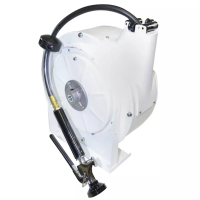Lit. No. 41298, Rev. 01 February 15, 2019
62
TROUBLESHOOTING
SOLENOID COIL ACTIVATION TEST (SCAT)
Off-Truck Testing
1. Remove the hydraulic unit covers.
2. Unplug the snowplow connectors from ports A
and B of the Plow Module.
3. Connect the diagnostic harness connectors
A and B to the matching ports on the Plow
Module (A to A and B to B).
4. Plug the connectors removed from the Plow
Module into the matching connectors on the
diagnostic harness (A to A and B to B).
5. Connect the snowplow control into the
4-position control connector on the diagnostic
harness.
6. Connect a 12V power source to the snowplow
battery cable (POSITIVE [+] 12V to the red
wire and NEGATIVE [–] to the black wire). Turn
ON the power source.
7. Turn the snowplow control ON and perform
a Solenoid Coil Activation Test (SCAT). See
the following chart for solenoid numbers and
functions. See the beginning of this section for
instructions on performing a SCAT.
NOTE: The green LED on the diagnostic
harness will illuminate when the motor relay
function is activated. This light only tests
the Plow Module's motor relay output. Refer
to Motor and Motor Relay Test section for
instructions on properly testing a motor relay.
8. After completing the SCAT, turn the snowplow
control OFF and disconnect the power source.
29290-1
Diagnostic
Harness
4-Position
Control
Connector
Plow Module (on hydraulic unit)
Plug
LED
Solenoid Coil Activation
Test (SCAT) Chart
Control
Function
Component(s)
Activated
Raise S3 Motor Relay
Lower S1
Angle Right S2, Motor Relay
Angle Left S2, S3, Motor Relay
INDIVIDUAL SOLENOID COIL TEST
1. Remove both wires from coil terminals.
2. Attach an ohmmeter across the coil terminals.
3. A reading that is not approximately 7 ohm
indicates coil is damaged and must be
replaced.
4. Attach an ohmmeter to one coil terminal and to
the steel washer at the end of the coil.
5. A reading that is not "open" indicates that the
coil has an internal short and needs to be
replaced.
6. If both readings are OK
(i.e., approximately 7 ohm across terminals and
"open" between terminal and washer), then the
coil is good.
NOTE: A good coil will draw approximately
1.5A.
9. Perform any required repairs and retest as
needed. Make sure to disconnect the power
source before removing the diagnostic
harness.

